# Environmental Challenges in the Region
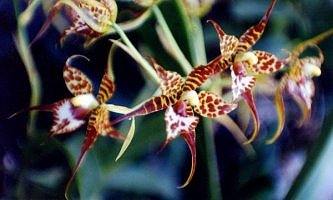
# "The only job we have left that expresses our humanity is to return species to their place and to take our place, a small place." --Bill Mollison
The Sierra Madre region of Chiapas, Mexico is an amazingly diverse environment with hot tropical forests a few kilometers away from coniferous cloud forest. There are species of orchids that are found only here. Flocks of lime-green parrots fly into the remaining sunlight when the late afternoon shadows cool their nesting grounds in winter. In the rainshadow there are cactus intermixed with fragrant copal and the gracious, grand guanacastle trees. This is the headwaters for 46 rivers to the Pacific side of the divide. Numerous other rivers flow inland to join the Grijalva River that flows from Guatemala through to the center of Chiapas.
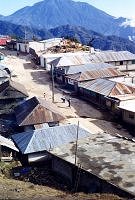
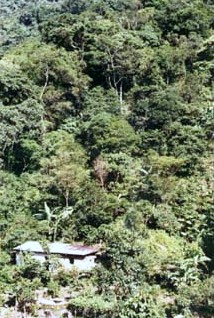
Once this massive watershed formed part of what was a continuous, lush Central American forest. But the Chiapas forest was severely damaged by a large scale commercial logging project in the 1980s. This deforestation has been so voracious that a NASA satellite photo taken in the mid 1990s clearly shows the outline of the Guatemala border where that nation’s forest meets the denuded mountains of the Mexican Sierra Madre. And using Google Earth, one can see a startling brown region where there should be emerald green. Animal populations have been seriously reduced. Immense areas of important habitat for migratory birds have been lost.
El Triunfo Rainforest, considered one of the top priority wild-land areas on earth to be protected, is being chewed away at the edges as poor farmers clear land for cornfields like relentless leaf-cutter ants. Clandestine logging operations in El Triunfo and throughout the Sierra are a serious threat to remaining old growth forest. With no real reforestation going on, the loss of biomass has global consequences.
All over Latin America, land-based communities are facing serious threats to their health and livelihoods from the environmental impact of mining on water and air quality. Much social unrest and conflict results as people find that their governments, bound by free trade rules and saddled with external debt, side with the corporations that seek to expliot the minerals. Unfortunately, 52 mining operations have been authorized in the Sierra Madre, without the free, prior and informed consent of the people who will be negatively affected if these go forward. A mine in Chico Muselo was closed by the government when the leader of the community group that opposed it was murdered in 2009. The Canadian company that operated the mine is under investigation for possible involvement.
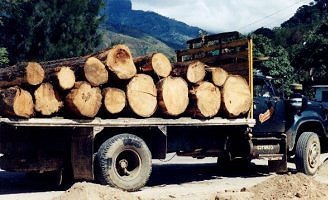
# The Big Picture
This small piece of the planet, the Sierra Madre, has an important role to play in the ecology of the Americas. Population studies of migratory songbirds that make it to the U.S. and Canada have shown that their numbers are dropping each year at an alarming rate. This is due to the increased use of agro-chemicals, pushed by U.S. aid policy and Latin American governments, and the continuing loss of habitat cut for farming in Central America. These birds are one part of the web of life that is calling us to attention as they show us how far the damage has gone.
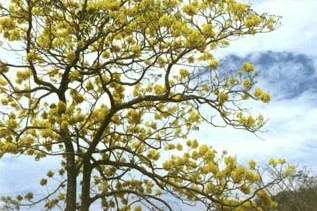
Old timers reminisce about the time when jaguars, toucans, monkeys, lynx, deer and other native creatures were common. But there are islands of forest remaining where one can catch glimpses into that past they remember. On slopes too steep to farm, misty clouds curl among the branches of old-growth trees filled with bromeliads and orchids. These places are the reserves of the seeds, bulbs, and spores needed to reforest. Fortunately, the local people want to preserve these areas as much as possible. They are the ones who must live with the consequences of the misuse of the watershed.
# Environmental degradation and it's impact on people's lives
In the Sierra Madre of Chiapas, as is the case elsewhere in the developing world, impoverished rural people must depend on an over-pressured environment for their survival. Changes in climate patterns have had a devastating impact on coffee harvests, the main source of income for thousands of poor families throughout the region. See Coffee Challenges. (opens new window) During the dry season many rivers flow with much less water and springs dry up. People suffer from the scarcity of water during this season. In the rainy season, torrential rains carry precious topsoil from the steep mountainsides, impoverishing soil quality for the forest and for crops.
Land use practices contribute to environmental degradation in the fragile watershed. The thousands of small-scale coffee farming families throughout the Sierra watched in dismay as drought and the widespread fires of the spring of 1998, sparked by the practice of burning of corn after harvest caused the delicate, white coffee flowers to turn yellow, wither and fall. By some estimates, eighty percent of the normal harvest was lost. The use of agrochemicals to make up for the deficient soils contaminates the water, soil, and the food produced and is a health hazard for the farmers and their families. Clearly there is an urgent need to help people earn a sustainable and dignified livelihood in ways that do no damage to the Earth.
In the Sierra Madre, as is the case elsewhere in the developing world, impoverished rural people must depend on an over-pressured environment for their survival. Climate change, soil erosion, and the scarcity of water contribute to the poor quality of life. The loss of resources means that the campesinos (rural farmers) can no longer depend on farming as their only source of income.
The result is that there is a mass exodus of able-bodied young men who are sent north by desperate families who pool money for bus fare with the hope that they will succeed in crossing illegally into the U.S. and find work. The money they send home sustains a large percentage of Sierra families.
# Catastrophic natural disasters and their impact
Then in September of 1998, Chiapas reaped the sad harvest of the deforestation of the Sierra Madre when fragile soils on steep mountainsides for hundreds of square miles could not withstand the three hurricanes (Xavier, Georges and Mitch) that for a second year have caused so much suffering and damage. Forty-six rivers that flow out of the Sierra literally buried coastal communities. In the Sierra, massive flooding, crushing rockslides and thousands of landslides destroyed many communities and left the landscape unrecognizable in many places. Then in 2005 Hurricane Stan hit Central America with even more devastating force causing the loss of over 40% of the land cultivated in coffee in the Sierra alone. The result of these catastrophies is great material loss to poor people and to infrastructure like roads and communication systems. This increase the threat of widespread hunger throughout the Sierra Madre, the most impoverished region of the state of Chiapas. It also creates a terrible sense of fear and insecurity in the survivors of the traumas that living through natural disasters causes. (Learn about our work to help survivors. (opens new window))
# Helping to repair the relationship between people and the Earth, a pragmatic approach
The struggle to rise above hunger and poverty is the most important motivation in impoverished communities. So, apart from our obvious duty to help our brothers and sisters to achieve a secure and dignified life, environmental work in the developing world best includes sustainable strategies to help the local people to progress economically.
Philosophically, we do not see people as separate from the natural world. Rather we seek ways to help the entire system, people included, to reach a balance within the carrying capacity of the land. In a damaged region like the Sierra Madre, this is a daunting task. But just as the voyage of a 1000 miles begins with the first step, reforestation takes place tree by tree, and establishing an ethic of right stewardship, person by person.
 The Sexto Sol Center
The Sexto Sol Center